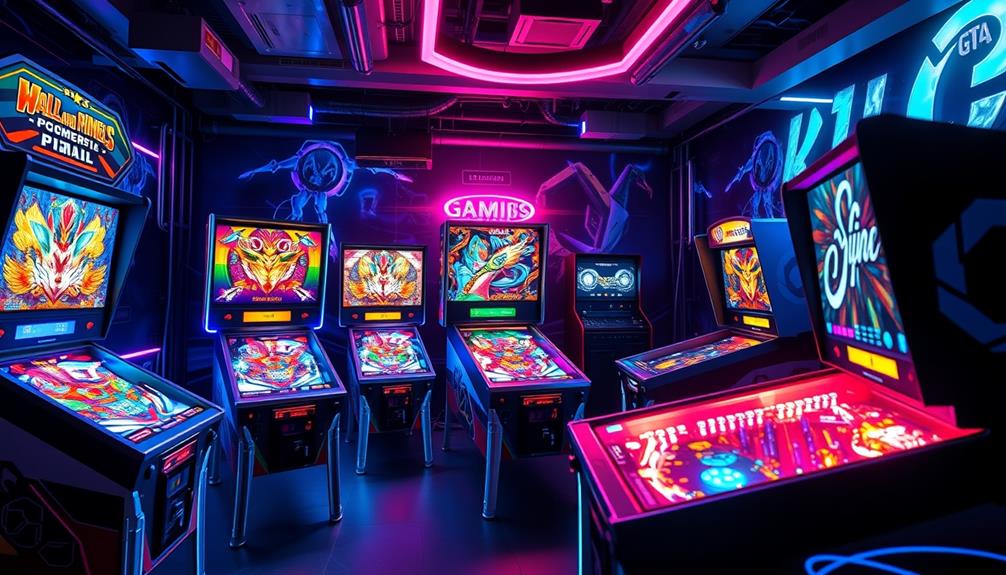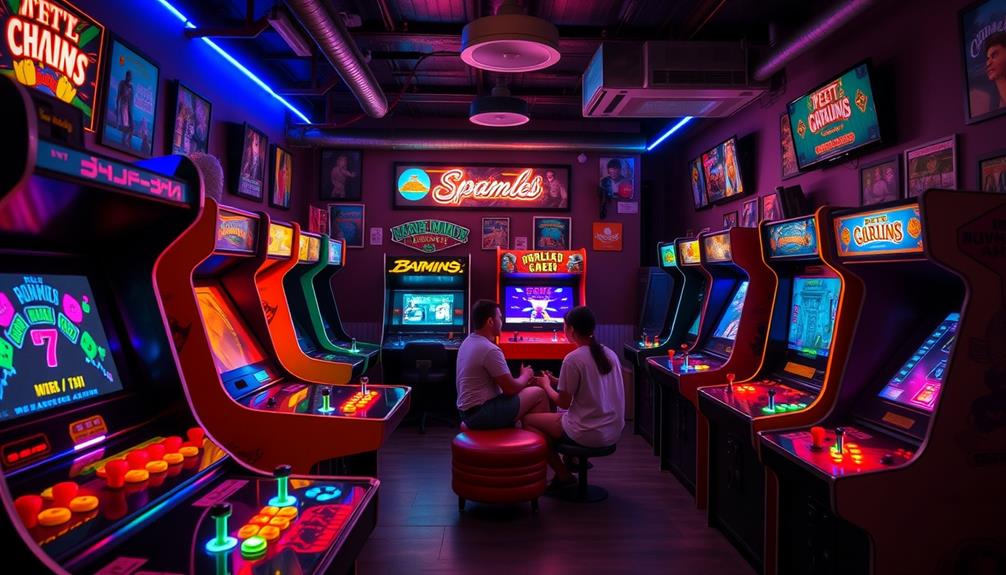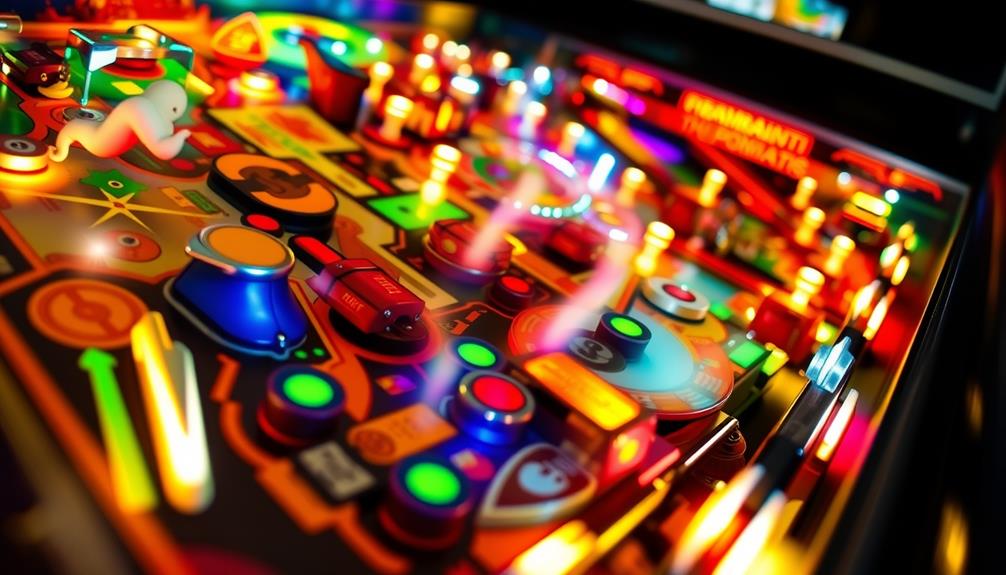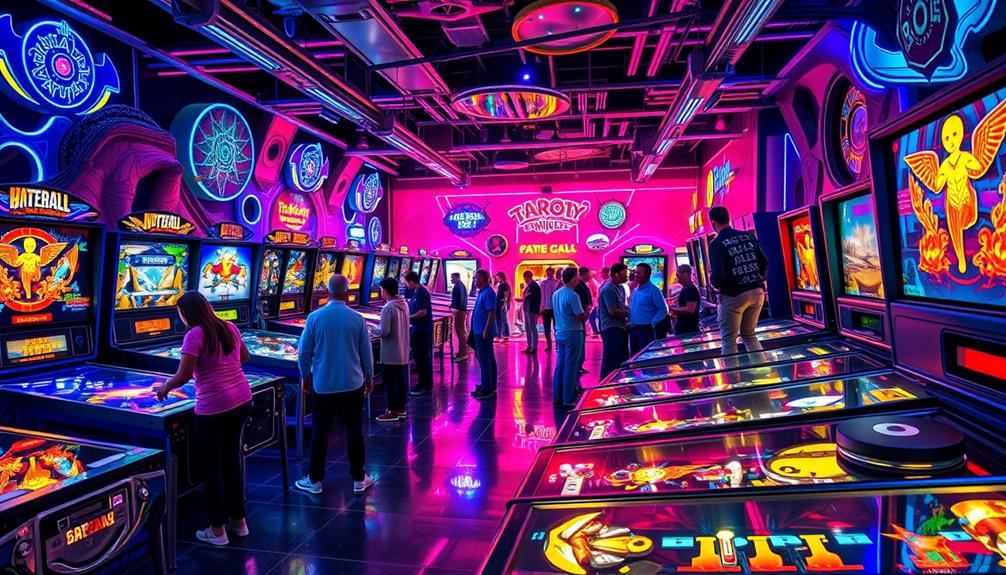If you are seeking to enhance your virtual pinball experience in 2025, I have compiled a list of the top nine GPUs that cater to various budgets and requirements. For those looking for entry-level gaming, options like the MSI Gaming GeForce GT 710 and APU with Radeon R7 Graphics offer affordability and satisfactory performance for older games. For mid-range choices, the ZOTAC Gaming GeForce RTX 3050 and 3060 deliver impressive visuals and smooth gameplay. For individuals desiring top-tier performance, the ASUS Dual GeForce RTX 4060 EVO is a solid option to consider. Stay tuned as I delve into each GPU’s distinct features to assist you in selecting the best fit for your setup.
Key Takeaways
- Choose GPUs with at least 4GB VRAM for smooth performance during intense virtual pinball gameplay.
- Look for models supporting 1080p resolution or higher to enhance visual fidelity.
- Ensure compatibility with DirectX 12 and Vulkan APIs for optimal rendering performance.
- Consider multi-display support to create a more immersive virtual pinball experience.
- Research performance benchmarks to guarantee a minimum of 60 FPS for responsive gaming.
MSI Gaming GeForce GT 710 Low Profile Graphics Card

If you're looking for an affordable and compact option for playing classic virtual pinball games, the MSI Gaming GeForce GT 710 Low Profile Graphics Card is a solid choice. This card boasts 2GB of DDR3 video memory and connects through VGA, DVI-D, or HDMI, making it versatile for various setups. With a maximum resolution of 4096 x 2160 at 24Hz via HDMI, it delivers impressive visuals for older titles. I've noticed it performs markedly better than integrated graphics, handling classics like Rome Total War effortlessly. Just keep in mind, it struggles with modern games. Installation can be tricky, so be ready for potential BIOS adjustments. Overall, it's a great option for light gaming and media consumption without breaking the bank.
Best For: Casual gamers and media consumers looking for an affordable graphics card that enhances performance over integrated options, particularly for older titles.
Pros:
- Offers significantly better performance than integrated graphics, making it suitable for light gaming.
- Compact low-profile design fits well in smaller systems, saving space.
- Versatile connectivity options (VGA, DVI-D, HDMI) provide flexibility for various setups.
Cons:
- Struggles with modern gaming titles, limiting its use for current games.
- Installation can be complicated, requiring potential BIOS updates and adjustments.
- Some users report noisy fan operation, which may be distracting in quiet environments.
Graphics Card GPU Mini Brace Support

The Graphics Card GPU Mini Brace Support is a must-have for gamers who want to protect their high-performance graphics cards, especially if you're running demanding titles like virtual pinball. We all know how important it is to prevent GPU sag, and this compact, aluminum support does just that. Weighing just 0.634 ounces, it's designed for easy, tool-free installation in under a minute. I appreciate the height-adjustable feature, allowing it to fit various chassis configurations effortlessly. Plus, the bottom hidden magnet design guarantees stability while protecting my graphics card. With a solid 4.3-star rating from users, I can confidently say this brace is a reliable choice for maintaining your setup's integrity, especially with heavier GPUs like the RTX 4090.
Best For: Gamers and PC builders looking to prevent GPU sag and ensure stability for heavy graphics cards in various chassis configurations.
Pros:
- Height-adjustable design accommodates different case sizes and setups.
- Easy tool-free installation allows for quick setup in under a minute.
- Aluminum construction provides durability and rust resistance.
Cons:
- May not fit well in specific case dimensions with low clearance.
- Effectiveness can vary based on the weight and size of the graphics card.
- Some users may find the magnet stability insufficient for very heavy GPUs.
ZOTAC Gaming GeForce RTX 3060 Twin Edge OC Graphics Card

For gamers seeking a solid balance of performance and affordability, the ZOTAC Gaming GeForce RTX 3060 Twin Edge OC Graphics Card shines as an excellent choice. With 12GB of GDDR6 memory and a boost clock of 1807 MHz, it handles 1080p gaming at high settings effortlessly. The IceStorm 2.0 cooling system keeps things cool, plus it's 8K-ready with multiple display outputs, making it versatile for various setups.
I've found that it runs older games at an impressive 325-355 FPS, which is fantastic for immersive gaming experiences like virtual pinball. Priced around $349.99, it offers great value compared to pricier options. Overall, it's a solid investment for average gamers looking to elevate their gaming experience.
Best For: Average gamers seeking a reliable graphics card that balances performance and affordability for 1080p gaming.
Pros:
- Excellent 1080p gaming performance at high settings.
- 12GB GDDR6 memory provides ample support for modern games and applications.
- Efficient cooling system with IceStorm 2.0 ensures stable performance during extended gaming sessions.
Cons:
- Not as powerful as newer 40 series graphics cards.
- Some users report fan noise during high-load situations.
- Limited future-proofing for upcoming AAA titles at ultra settings.
PNY NVidia Quadro K1200 Low Profile Graphics Card

Looking to enhance your virtual pinball experience? The PNY NVidia Quadro K1200 Low Profile Graphics Card might be just what you need. With its compact design, it fits perfectly in small form factor desktops and traditional ATX towers. This card delivers up to 2x the graphics performance compared to competing products, thanks to its 4GB GDDR5 memory and impressive 4096 x 2160 resolution. I appreciate its ability to support four monitors, including dual 4K setups, making it ideal for immersive gaming. Users love its quiet operation and low power consumption, which is a bonus for long gaming sessions. Just keep in mind some initial driver setup may be needed, but overall, it's a solid choice for virtual pinball enthusiasts.
Best For: Virtual pinball enthusiasts and professionals seeking a compact, high-performance graphics solution for multi-monitor setups.
Pros:
- Supports up to four monitors, including dual 4K displays, enhancing immersive gaming and productivity.
- Quiet operation and low power consumption, making it suitable for long gaming or work sessions.
- Significant performance upgrade over previous models, ideal for CAD applications and general use.
Cons:
- Initial driver setup may be required, which could be a hurdle for less tech-savvy users.
- Compatibility issues noted with Linux drivers, potentially limiting use for some operating systems.
- Limited memory capacity compared to higher-end graphics cards, which might affect performance in more demanding applications.
ZOTAC Gaming GeForce RTX 3050 Twin Edge OC Graphics Card

Equipped with 8GB of GDDR6 memory and NVIDIA's Ampere architecture, the ZOTAC Gaming GeForce RTX 3050 Twin Edge OC Graphics Card stands out as an excellent choice for virtual pinball enthusiasts. Its 2560 CUDA cores and 1807 MHz boost clock deliver impressive performance, enhancing gameplay smoothness and frame rates compared to older models like the GTX 1650. The dual-fan IceStorm 2.0 cooling system keeps temperatures low, even during intense gaming sessions. Plus, with multiple outputs, including HDMI 2.1 and DisplayPort 1.4a, you can easily connect to multiple displays. Priced competitively, this GPU offers great value for both gaming and content creation, making it a versatile addition to any setup.
Best For: Budget gamers and content creators seeking a balance between performance and affordability in a compact graphics card.
Pros:
- Impressive performance with 8GB GDDR6 memory and 2560 CUDA cores, enhancing gameplay smoothness.
- Effective cooling solution with dual-fan IceStorm 2.0 technology, maintaining low temperatures during intensive use.
- Versatile connectivity options, including HDMI 2.1 and multiple DisplayPort outputs, allowing for multiple display setups.
Cons:
- Limited ray tracing performance compared to higher-end models, which may impact graphics quality in demanding games.
- Recommended power supply of 450 watts may be a consideration for users with lower wattage systems.
- Size may not fit in all compact PC builds due to its dual-slot design and length.
AMD A8-7600 Quad-Core Desktop Processor

The AMD A8-7600 Quad-Core Desktop Processor stands out as an excellent choice for budget-conscious gamers who want a reliable option for virtual pinball. With its 3.1 GHz clock speed and 10 compute cores, this processor can handle multiple tasks simultaneously, making it perfect for running virtual pinball software smoothly. The integrated Radeon R7 graphics cores allow for decent gaming performance, especially at 720p, which is ideal for older titles and casual gaming. While it's not suited for 4K play, it excels at HD video playback without needing an additional graphics card. Plus, its energy efficiency and compact design make it a great fit for low-cost builds. Overall, it's a solid choice for entry-level setups.
Best For: Budget-conscious gamers seeking a reliable processor for casual gaming and basic computing tasks.
Pros:
- Energy-efficient design suitable for low-cost builds.
- Decent integrated graphics performance for HD video playback and older games.
- Multi-tasking capability with 10 compute cores, allowing smooth operation of various applications.
Cons:
- Not suitable for 4K playback, requiring a discrete graphics card for high-resolution content.
- Stock cooler may be insufficient, prompting the need for aftermarket cooling solutions.
- Limited future upgrade options due to compatibility with specific motherboards.
ZOTAC Gaming GeForce RTX 3060 AMP White Edition Graphics Card

For gamers and virtual pinball enthusiasts seeking a powerful yet stylish GPU, the ZOTAC Gaming GeForce RTX 3060 AMP White Edition stands out with its impressive 12GB of GDDR6 memory and NVIDIA's cutting-edge Ampere architecture. This card features 2,560 CUDA cores and handles demanding games like Fortnite and GTA effortlessly at ultra settings, often exceeding 80 fps. The IceStorm 2.0 cooling system guarantees quiet operation, while the sleek white design fits beautifully in any setup. With support for 8K resolution and multiple displays, it's perfect for immersive virtual pinball experiences. Plus, installation is a breeze for beginners. Overall, this GPU is a fantastic choice for anyone looking to elevate their gaming experience in 2025.
Best For: Gamers and content creators seeking a powerful and stylish graphics card for high-performance gaming and immersive experiences.
Pros:
- Excellent performance for 1080p gaming at ultra settings with smooth frame rates.
- Quiet operation thanks to the IceStorm 2.0 cooling system.
- Stylish white design enhances aesthetics in any gaming setup.
Cons:
- Wider dimensions may affect compatibility with smaller cases.
- Does not support SLI for multi-GPU setups.
- Some users reported issues with product condition upon arrival.
MSI Gaming GeForce RTX 3060 Graphics Card

With its impressive 12GB of GDDR6 memory, the MSI Gaming GeForce RTX 3060 Graphics Card stands out as an excellent choice for gamers and virtual pinball enthusiasts alike. This GPU, powered by NVIDIA's Ampere architecture, boasts a clock speed of 1710 MHz and delivers smooth gameplay, easily handling modern AAA titles at high settings. I love its efficient cooling system, featuring the Torx Twin Fan design that keeps the card quiet while maintaining safe temperatures during long gaming sessions. Plus, the maximum resolution of 7680 x 4320 guarantees stunning visuals. With a solid build quality and positive user feedback, it's hard to go wrong with this card. Just verify it's compatible with your setup before purchasing!
Best For: Gamers and content creators seeking high performance and efficient cooling in a mid-range graphics card.
Pros:
- High performance with 12GB GDDR6 memory, perfect for modern AAA games and demanding applications.
- Efficient cooling system with Torx Twin Fan design ensures quiet operation and safe temperatures.
- Solid build quality and sleek design enhance durability and aesthetics.
Cons:
- Some users recommend models with more fans for improved cooling performance.
- May require checking compatibility with existing systems before purchase.
- Limited availability due to high demand in the gaming market.
ASUS Dual GeForce RTX 4060 EVO OC Edition Graphics Card

Offering impressive performance and cutting-edge technology, the ASUS Dual GeForce RTX 4060 EVO OC Edition Graphics Card stands out as an excellent choice for virtual pinball enthusiasts. With 8GB of GDDR6 memory and powered by NVIDIA's DLSS3 and Ada Lovelace architecture, this card delivers stunning graphics. The 4th Generation Tensor Cores allow up to 4x performance improvement with DLSS 3, while the 3rd Generation RT Cores enhance ray tracing capabilities by up to 2x. Its axial-tech fan design guarantees silent operation, and the 0dB technology keeps noise at bay during intense gaming sessions. With a solid rating of 4.7 out of 5 stars, it's praised for both performance and aesthetics. This GPU truly elevates the pinball experience.
Best For: Gamers and virtual pinball enthusiasts seeking high-performance graphics and stunning visuals in their gaming experience. Whether you’re diving into the immersive world of virtual pinball or playing the latest AAA titles, having a powerful and reliable setup is essential. The best PCs for visual pinball are designed to deliver smooth gameplay, crisp details, and fast response times, ensuring you never miss a beat. With cutting-edge GPUs and high-quality displays, these systems take your gaming to the next level.
Pros:
- Impressive performance with 8GB GDDR6 memory and NVIDIA DLSS3 technology for enhanced graphics.
- Silent operation thanks to axial-tech fan design and 0dB technology, ensuring a quiet gaming environment.
- High customer satisfaction with a 4.7 out of 5-star rating, indicating reliability and strong performance in AAA games.
Cons:
- Some users reported occasional black screen issues that required power management adjustments.
- Limited to PCIe 4.0 interface, which may not utilize the full potential of newer motherboard technologies.
- Weight and dimensions may pose challenges for compact builds or systems with limited space.
Factors to Consider When Choosing a GPU for Virtual Pinball

When I think about choosing a GPU for virtual pinball, several key factors come to mind. You'll want to evaluate graphics performance, software compatibility, and how well it handles your display's resolution. Plus, don't forget about cooling solutions, noise levels, and whether your power supply can handle it all.
Graphics Performance Requirements
Choosing the right GPU for virtual pinball is vital for achieving an immersive experience. I've found that aiming for at least 1080p resolution is essential for ideal visual fidelity. If you want to fully enjoy the stunning graphics and intricate details, don't settle for anything less. A minimum of 4GB of VRAM is also a must; it guarantees smooth performance, especially during those intense moments filled with visual effects and multi-layered graphics.
It's important to look for a GPU that supports DirectX 12 and Vulkan APIs, as these technologies greatly enhance rendering performance. Trust me, the difference is noticeable in modern pinball titles. Additionally, you should aim for frame rates of 60 FPS or higher for a responsive gaming experience. Fast-paced gameplay is a hallmark of virtual pinball, and nothing ruins the fun like lag.
Compatibility With Pinball Software
While many gamers focus on raw performance, compatibility with pinball software is equally vital when selecting a GPU for virtual pinball. First, I always check if the GPU supports the latest DirectX and OpenGL versions, as most pinball simulation software relies on these for ideal visuals and performance. It's essential to look at the minimum and recommended system requirements for the software you plan to use. I aim for a GPU that meets or exceeds these specs for a seamless experience.
Additionally, I consider a GPU's ability to handle multi-display setups. Virtual pinball feels immersive when using multiple screens, so having a GPU that supports several outputs can enhance gameplay markedly. I also verify that the GPU has enough video memory (VRAM) to manage high-resolution textures, especially with detailed pinball tables.
Lastly, I review performance benchmarks in 3D rendering and gaming scenarios. Higher frame rates not only elevate the gameplay experience but also guarantee smooth and fluid interactions during intense gaming sessions. Keeping these compatibility factors in mind will assure you choose the best GPU for an enjoyable virtual pinball experience.
Resolution and Display Quality
In the domain of virtual pinball, resolution and display quality play a vital role in creating an engaging experience. High resolution is essential for enhancing the detail and clarity of pinball tables, immersing you in the action. I recommend aiming for a graphics card that supports at least 1080p (1920 x 1080) resolution, as this is the standard for many modern setups. If you want to take your visuals to the next level, consider GPUs capable of 4K resolution (3840 x 2160). This not only gives you stunning graphics but also vibrant colors that elevate your gaming experience.
It's equally important to guarantee your GPU can maintain high frame rates—60 FPS or above—at your chosen resolution. This will keep your gameplay smooth and free from lag or stuttering. Additionally, look for GPUs that support advanced features like anti-aliasing and HDR (High Dynamic Range). These features greatly improve visual fidelity and realism in virtual pinball simulations, making each game feel even more lifelike. By prioritizing resolution and display quality, you'll truly enhance your virtual pinball experience.
Cooling Solutions and Noise
When it comes to enjoying virtual pinball, a GPU's cooling solutions and noise levels can greatly impact your overall experience. I've learned that effective cooling, like dual-fan designs and advanced technologies, is vital for maintaining top performance during those long gaming sessions. If a GPU overheats, it can lead to thermal throttling, which means less fun and more frustration.
Noise levels are another key factor. I appreciate GPUs with features like 0dB technology or low-noise fan designs, as they keep the gaming atmosphere quiet without sacrificing cooling efficiency. A noisy GPU can distract from the immersive experience that virtual pinball offers.
Additionally, GPUs with higher power consumption may need robust cooling solutions. So, I always consider the radiator size and airflow design when choosing my setup. Proper ventilation in the case is also important; it allows air to circulate freely around the GPU, minimizing hot spots. Anti-sag supports can further enhance cooling by keeping the GPU secure and stable. All these factors together guarantee that my gaming experience remains smooth, enjoyable, and free from overheating issues.
Power Supply Considerations
After verifying you have a quiet and cool GPU, the next step is considering the power supply. It's essential to choose a PSU with a wattage rating that meets or exceeds your GPU's power consumption. For lower-end cards, aim for around 300W, while mid to high-end models typically require 450W or more.
Make certain the PSU has the necessary power connectors, like 6-pin or 8-pin, to guarantee proper power delivery and peak performance. I also recommend considering the efficiency rating; a PSU with an 80 Plus certification will provide better energy efficiency and reduce heat output, which is a big plus during long virtual pinball sessions.
Don't forget to account for your entire system's power draw, including the CPU, motherboard, and any peripherals. This will help you determine the right PSU capacity and avoid any power shortages. Finally, be mindful of the PSU's form factor and its compatibility with your case. Some compact builds may need a specific size or modular design to maintain airflow and fit snugly. Taking these factors into account will guarantee a seamless gaming experience!
Size and Form Factor
Choosing the right size and form factor for your GPU is vital for guaranteeing it fits seamlessly within your PC case. GPUs come in various dimensions, ranging from low-profile designs to larger, dual-slot configurations. If you're working with a compact build, low-profile graphics cards, typically around 6.6 inches long, are perfect for small form factor (SFF) cases that have limited internal space.
On the other hand, standard-sized GPUs usually exceed 9 inches in length, so you'll need to check your case for adequate clearance to avoid obstruction and guarantee proper airflow. Dual-slot GPUs, while powerful, can occupy more vertical space on the motherboard, which might limit access to adjacent slots and impact your system's overall layout and cooling efficiency.
It's also important to take into account the GPU's mounting orientation and any additional components, like cooling solutions, which may affect the available space in your case. By evaluating these factors, you can avoid compatibility issues and create a smooth, enjoyable virtual pinball experience without any hiccups.
Budget and Cost Effectiveness
Finding the right GPU for your virtual pinball setup isn't just about size; budget plays a considerable role too. I've learned that balancing performance and cost is essential, especially since higher-end models can range from $349.99 to over $800. If you're looking for budget options, you might find GPUs around $100 that can handle less demanding visual effects just fine.
Before you plunge in, consider the minimum system requirements for the virtual pinball software you plan to use. Some programs will run adequately on lower-cost GPUs, but if you want peak performance, you may need to spend closer to $300. Evaluating the longevity and efficiency of a GPU is also crucial; a more powerful card might save you from frequent upgrades down the line.
Don't forget to look at the price-to-performance ratio. Assess how many frames per second (FPS) a GPU can deliver at your desired resolution. Finally, be aware of potential extra costs, like power supply upgrades or cooling solutions, especially for those high-end options. These factors can greatly impact your overall budget for the virtual pinball experience you're aiming for.
Future Upgrade Potential
When considering future upgrade potential for your virtual pinball setup, it's vital to look beyond just the current specifications of a GPU. First, I recommend focusing on the architecture and memory capacity. Opt for a GPU with at least 8GB of VRAM, as this guarantees smooth handling of detailed graphics and multiple displays. For future-proofing your virtual pinball setup, it’s also important to consider the compatibility of the GPU with the latest technology and APIs, such as DirectX 12 and Vulkan. Additionally, keep an eye out for GPUs that offer advanced cooling solutions and efficient power consumption for longevity and stability. When it comes to the ultimate performance mini pcs, prioritize a GPU that complements the overall system specs and capabilities for optimal gaming experience.
Next, make certain the GPU supports at least DirectX 12 and Vulkan API. These technologies can greatly enhance performance and graphical fidelity in virtual pinball software, making your experience richer. Additionally, check for a sufficient number of display outputs—multiple HDMI and DisplayPort options are ideal for a multi-screen setup.
Don't overlook the power supply requirements; a more powerful GPU may necessitate a higher wattage PSU, so plan accordingly. Finally, consider the cooling solutions of the GPU. Effective cooling is vital, especially during long gaming sessions, and it's even more important in compact setups where airflow can be limited. By keeping these factors in mind, you'll guarantee your GPU choice not only meets your current needs but also accommodates future upgrades seamlessly.
Frequently Asked Questions
What Is the Ideal VRAM Size for Virtual Pinball Gaming?
When I choose a GPU for virtual pinball, I find 4GB of VRAM works well for most setups. If I want better performance and future-proofing, I'd consider going for 6GB or more.
Can I Use Integrated Graphics Instead of a Dedicated GPU?
I've tried using integrated graphics, but I found it limits performance. For the best experience, especially in demanding games, a dedicated GPU really makes a difference. You'll enjoy smoother gameplay and better visuals.
How Do I Install a New GPU in My System?
Installing a new GPU's like inviting a skilled musician to your orchestra. First, I power down my system, open the case, slot it in gently, secure it, and finally, connect everything before powering up again.
Do Virtual Pinball Games Utilize Ray Tracing Technology?
Yeah, virtual pinball games can utilize ray tracing technology. I've noticed that it enhances lighting and reflections, making the experience more immersive. If you've got a capable GPU, you'll definitely enjoy the added visual fidelity.
What Are the Power Requirements for High-End GPUS?
Imagine a roaring engine; high-end GPUs need significant power, typically around 300 to 750 watts. I've found that ensuring my power supply matches these requirements keeps everything running smoothly and avoids unexpected shutdowns during intense gaming sessions.
Conclusion
Choosing the right GPU for virtual pinball can feel like picking the perfect cherry from a sundae—there are so many great options out there! Each card has its own strengths, and it all comes down to what fits your gaming setup and budget best. Whether you opt for the budget-friendly GT 710 or the powerful RTX 4060, you'll elevate your gaming experience. So, take your time, weigh your options, and get ready to enjoy some fantastic virtual pinball action!









